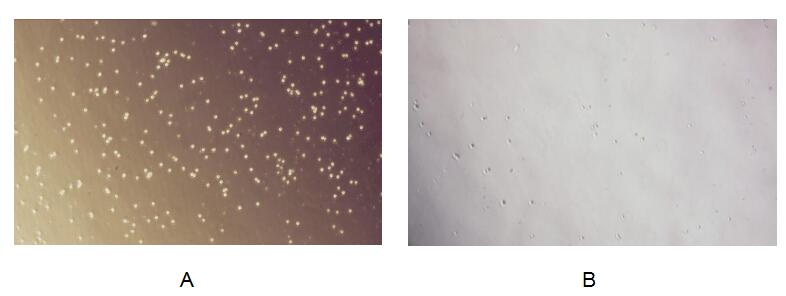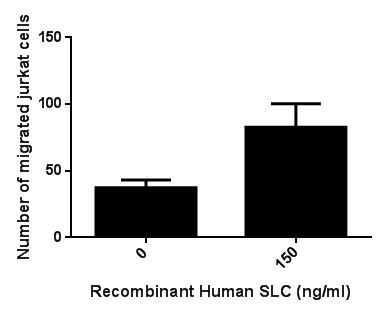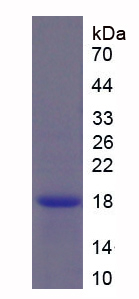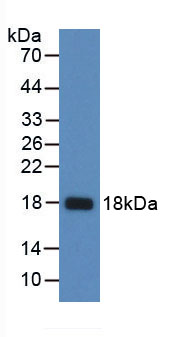Active Secondary Lymphoid Tissue Chemokine (SLC) 

CCL21; 6Ckine; CKb9; ECL; SCYA21; TCA4; ECL; Chemokine(C-C-Motif)Ligand 21; Beta Chemokine Exodus-2; Efficient Chemoattractant For Lymphocytes
- UOM
- FOB US$ 211.00 US$ 528.00 US$ 1,056.00 US$ 3,168.00 US$ 7,920.00
- Quantity
Overview
Properties
- Product No.APB575Hu01
- Organism SpeciesHomo sapiens (Human) Same name, Different species.
- ApplicationsCell culture; Activity Assays.
Research use only - DownloadInstruction Manual
- CategoryCytokineTumor immunityInfection immunity
- Buffer Formulation20mM Tris, 150mM NaCl, pH8.0, containing 1mM EDTA, 1mM DTT, 0.01% SKL, 5% Trehalose and Proclin300.
- Traits Freeze-dried powder, Purity > 97%
- Isoelectric Point10.0
Sign into your account
Share a new citation as an author
Upload your experimental result
Review

Contact us
Please fill in the blank.
Activity test

Secondary Lymphoid-tissue Chemokine (SLC) is a recently identified CC chemokine that is constitutively expressed in various lymphoid tissues and is a potent and specific chemoattractant for lymphocytes. Thus, chemotaxis assay used 24-well microchemotaxis system was undertaken to detect the chemotactic effect of SLC on the human T-lymphocyte leukemia cell line Jurkat. Briefly, Jurkat cells were seeded into the upper chambers (100uL cell suspension,106 cells/mL in RPMI 1640 with FBS free) and SLC (1ng/mL, 15ng/mL and 150ng/mL diluted separately in serum free RPMI 1640) was added in lower chamber with a polycarbonate filter (8um pore size) used to separate the two compartments. After incubation at 37℃ with 5% CO2 for 1h, the filter was removed, then cells in low chamber were observed by inverted microscope at low magnification (×100) and the number of migrated cells were counted at high magnification (×400) randomly (five fields for each filter). Result shows SLC is able to induce migration of Jurkat cells. The migrated Jurkat cells in low chamber at low magnification (×100) were shown in Figure 1. Five fields of each chamber were randomly chosen, and the migrated cells were counted at high magnification (×400). Statistical results were shown in Figure 2. The optimum chemotaxis of SLC occurs at 15-150ng/mL.(A)Jurkat cells were seeded into the upper chambers and serum free RPMI 1640 with 150ng/mL SLC was added in lower chamber, then cells in lower chamber were observed at low magnification (×100) after incubation for 1h;
(B)Jurkat cells were seeded into the upper chambers and serum free RPMI 1640 without SLC was added in lower chamber, then cells in lower chamber were observed at low magnification (×100) after incubation for 1h.
Figure. The chemotactic effect of SLC on Jurkat cells

Figure .The chemotactic effect of SLC on Jurkat cells.
Usage
Reconstitute in 20mM Tris, 150mM NaCl (PH8.0) to a concentration of 0.1-1.0 mg/mL. Do not vortex.
Storage
Avoid repeated freeze/thaw cycles. Store at 2-8°C for one month. Aliquot and store at -80°C for 12 months.
Stability
The thermal stability is described by the loss rate. The loss rate was determined by accelerated thermal degradation test, that is, incubate the protein at 37°C for 48h, and no obvious degradation and precipitation were observed. The loss rate is less than 5% within the expiration date under appropriate storage condition.
Increment services
-
 BCA Protein Quantification Kit
BCA Protein Quantification Kit
-
 Molecular Mass Marker for Protein
Molecular Mass Marker for Protein
-
 Monoclonal Antibody Customized Service
Monoclonal Antibody Customized Service
-
 Polyclonal Antibody Customized Service
Polyclonal Antibody Customized Service
-
 Protein Activity Test Experiment Service
Protein Activity Test Experiment Service
-
 Electrophoretic Mobility Shift Assay (EMSA) Experiment Service
Electrophoretic Mobility Shift Assay (EMSA) Experiment Service
-
 Buffer
Buffer
-
 Lentivirus Packaging Experiment Service
Lentivirus Packaging Experiment Service
-
 Adenovirus Packaging Experiment Service
Adenovirus Packaging Experiment Service
-
 Real Time PCR Experimental Service
Real Time PCR Experimental Service
-
 Spike RBD Protein (S-RBD)
Spike RBD Protein (S-RBD)
-
 Protein G
Protein G
-
 Protein A
Protein A
Citations
- 类风湿关节炎血清中CCL19 和CCL21 的表达水平与肺间质病变的关系:
- Dysregulation of miR-142 results in anxiety-like behaviors following single prolonged stressPubmed: 30857769
- Sigma-1 receptor activation ameliorates LPS-induced NO production and ROS formation through the Nrf2/HO-1 signaling pathway in cultured astrocytesPubmed: 31330223
- miR-132 Regulates PTSD-like Behaviors in Rats Following Single-Prolonged Stress Through Fragile X-Related Protein 1Pubmed: 32333305
- miR-142 downregulation alleviates rat PTSD-like behaviors, reduces the level of inflammatory cytokine expression and apoptosis in hippocampus, and?¡33407653
- MiR-153 downregulation alleviates PTSD-like behaviors and reduces cell apoptosis by upregulating the Sigma-1 receptor in the hippocampus of rats exposed to …Pubmed:35259352










